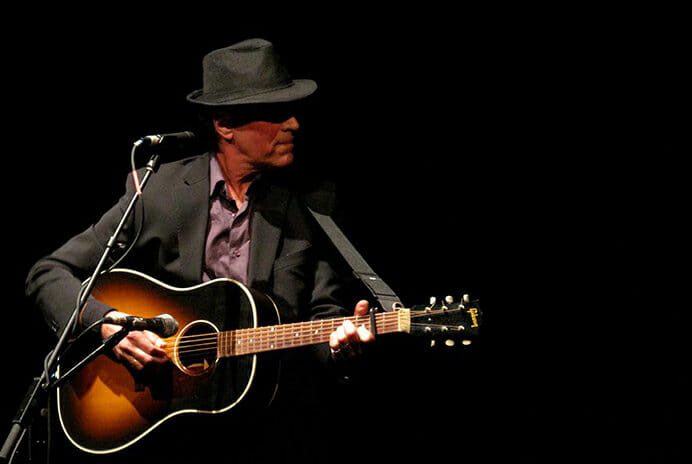
Photo: Carol Rothman
***
Stop us if you’ve heard this one before. A young singer-songwriter, living in a landlocked state, throws his guitar over his shoulder and heads east to Greenwich Village, where a folk singer can pocket a few coins if the people like what they hear. Before long, kindred spirits take notice and start recording his tunes— the list eventually includes such high-profile troubadours of the day as Judy Collins, Johnny Cash, Linda Ronstadt and, yes, Bob Dylan.
Eric Andersen, now 79, doesn’t live in the Village anymore, but rather in the Netherlands. He is still performing and creating though—and still reaching new fans, some of whom are eager to remake his timeless songs in their own image. You can hear a bunch of those young acolytes— alongside such elders as Janis Ian, Willie Nile, Happy Traum and the late Rick Danko—on the recently released compilation Tribute to a Songpoet: Songs of Eric Andersen. The three-disc, 42-track compendium also includes a previously unreleased Dylan take on “Thirsty Boots,” arguably Andersen’s best-known composition (featuring accompaniment by David Bromberg and Al Kooper), and Ronstadt’s 1972 workup of “(I Ain’t Always Been) Faithful,” a tune from Andersen’s beloved Blue River LP of that same year.
The collection arrives on the heels of The Songpoet, a 2021 documentary that looks back on the life and, most important, Andersen’s artistry. The subject of all this attention is, of course, grateful that he’s receiving so much renewed appreciation this late in his career, but he approaches it all with a bit of bemusement.
“I didn’t have anything to do with [making the film],” he says. “I watched it like any other audience member. You’re watching this person, and the person happens to be you. All of us are so used to looking at reality from the inside looking out, through our eyes. We’re not used to seeing ourselves how others see us. In a film, you’re forced to see all of that. The amusing aspect was that I don’t remember things looking the way they do in the film, and I don’t recall thinking or feeling that way at all when I was age 25. But they say photos don’t lie.”
The tribute album boasts tracks from several of Andersen’s family members— musical artists in their own right—and such denizens of the singer-songwriter and indie-rock communities as Syd Straw, Richard Barone, Allison Moorer, Albert Lee, Dom Flemons, Amy Helm, Lenny Kaye, Elliott Murphy, Mary Chapin Carpenter, Larry Campbell, Teresa Williams and Arlen Roth. Andersen’s “Rains Are Gonna Come” is covered by Evan Stanley, who isn’t yet as famous as his dad, Kiss’ Paul Stanley, but might be someday.
The chosen songs are well-matched with the artists performing them, drawn from the more than 20 albums Andersen has released since his 1965 Vanguard Records debut, Today Is the Highway. Tracks are plucked not only from Andersen’s ‘60s work for that label but from his later releases for Columbia and a number of indie imprints. The album, which was released on the Y&T Music label, was executive produced by Jim Wurster, who previously greenlit a single-disc tribute to the late Fred Neil, and produced by Steve Addabbo, a longtime Andersen associate who accompanies the singer on guitar at live gigs.
“It’s a beautiful tribute,” Andersen says. “It kind of morphed from one CD to three. It probably could have gone to four, but it had to stop. I think it shows people that there’s a lot of variety in my writing.”
For Andersen, the songwriting has always been the engine driving him. “Writing is essentially what it’s been all about for me from the beginning, making the invisible become visible,” he says. “Things you see that nobody else sees, you can write down and make it visible.”
From the start, Andersen cut his own path. He hung out with the New York folk crowd, sure, but he was also tight with fellow Pittsburgh native Andy Warhol and his protégé Lou Reed.
“I used to go watch [Andy] paint,”he says. “And Lou was my best friend in the city.”
Andersen spent most of his nights during his Village days hitting the clubs, not so much to check out the folk competition but to sit at the feet of blues and jazz greats like Lightnin’ Hopkins, Muddy Waters and Charles Mingus.
In 1970, Andersen hopped aboard the Festival Express, a cross-Canada train ride that touched down at various stations along the way, where folks like the Grateful Dead, Janis Joplin, The Band and The Flying Burrito Brothers entertained the locals. Andersen was the only solo acoustic artist on the bill. A few years later, he sat down with Bob Weir to write a tune, which became the opening segment of the Grateful Dead’s “Weather Report Suite.” And he fondly remembers picking guitars with Jerry Garcia in a hotel room following a Dead gig, circa ‘71 or ‘72. As Andersen says, “He loved a song of mine called ‘Come to My Bedside, My Darling.’ He started playing it on the guitar and the bridge popped off. It was a Martin 00-18. He just kept playing as if nothing happened. Maybe we were on acid; I don’t know. But he just kept playing.”
Andersen also forged a relationship with The Band’s Danko, and they recorded two albums together with the Norwegian artist Jonas Fjeld.
Although he’s recently had reason to look back on his own past, Andersen admits that he never plays his old recordings— in fact, he doesn’t even own copies. He’s more interested in looking forward. “I’ve been working on an album since 2011, since before they started making the film,” he says. “I’m planning to do a little recording when I go to New York in a couple weeks. Then I think I’m gonna come back in the winter and finish it. I just keep writing new stuff.”
